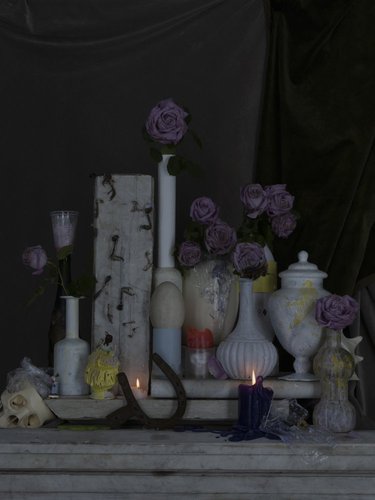John Hurrell – 6 December, 2021
In the accompanying Starkwhite essay, Andrew Paul Wood discusses the significance of Tarot cards to this project as referenced by the show's title. Here an invitation is extended to the curious viewer to make connections between the eight rectangles on display and the dominant iconographies in a 78 card Tarot pack. All the photograph titles encourage this—just as they would if they were conventional cautionary Dutch still life paintings.
Eight large photographs downstairs at Starkwhite continue Fiona Pardington’s inventive investigation of the Still Life genre. These ones are darker than those of the past, with the occasional candle included. There is a lovely pervading greyness throughout, but colour is never absent.
The soft lighting establishes the gentlest and most contemplative of moods. Pardington‘s works are oriented around the process of stacking, piles of assorted evocative objects (apparently meaningful to the artist, and often written or drawn upon) are seen through a smoky haze, household articles mingled with ‘occult’ items to be placed as adjacent towers or teetering heaps within very large cabinets.
Pardington‘s whopper tilted trays of symbols are exhilarating vertical heaps, emphasising pattern, plasticity of light-raked cylindrical form, and drawn or scrawled line. The colour is carefully muted, with just enough illumination to be able to read the spines of books or labels of jars-but not too bright. The emphasis on the vertical reminds me of Louise Nevelson’s relief sculpture. There is a vaguely cathedral like quality (your eyes tend to drift north), mixed with the sense that for each photograph Pardington has taken one of Nevelson’s crammed shallow boxes (her gridded modules), and enlarged it.
These orchestrated boxed-in grey platforms holding up tall urns, vases with precariously balanced shells, (maybe plaster or fabric) roses, furtive china objects, toys, flat books and inverted (plastic?) skulls, maintain a mystery encased in leaning shadows. A Victorian museological ambience pervades, preserved items being coated with the fine grey dust of history-kept in the half light for years.
Pardington’s use of scrawled text on photographed ceramics is likewise interesting—a bit like the scribbled pencil-line decoration used by Tony Cragg on some of his surfaces—but here seemingly a form of sympathetic magic where votive text aspires to alter reality. In her Sex of Metals photographs of the late eighties Pardington used a lot of written (typed) collaged language on the mount, densely filling the space between image and outer frame. Now the text is on the image proper. It (because it is murky) almost is the image proper.
In the accompanying Starkwhite essay, Andrew Paul Wood discusses the significance of Tarot cards to this project as referenced by the show’s title. Here an invitation is extended to the curious viewer to make connections between the eight rectangles on display and the dominant iconographies in a 78 card Tarot pack. All the photograph titles encourage this—just as they would if they were conventional cautionary Dutch still life paintings.
However these images go well beyond mere Vanitas works, being much more complicated in their moral purpose, with an interest in the occult (with or without scare quotes) that would be deeply offensive to seventeenth century Dutch Protestantism. Perhaps twenty-first century Aotearoa / New Zealand’s multi-cultural pluralism too? Particularly if religion and spirtuality are deemed authentic but magic and the occult are not.
John Hurrell








 Two Rooms presents a program of residencies and projects
Two Rooms presents a program of residencies and projects Advertising in this column
Advertising in this column



This Discussion has 0 comments.
Comment
Participate
Register to Participate.
Sign in
Sign in to an existing account.